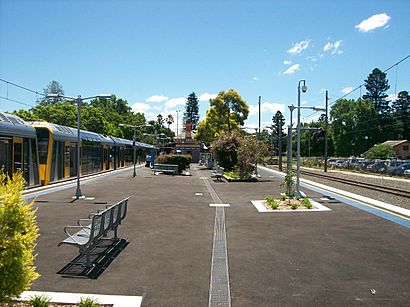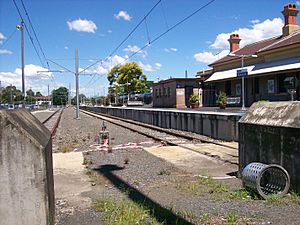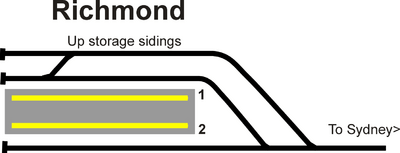Richmond railway station, Sydney facts for kids
Quick facts for kids
Richmond
|
|||||||||||||||
|---|---|---|---|---|---|---|---|---|---|---|---|---|---|---|---|

Westbound view in November 2012
|
|||||||||||||||
| Location | East Market Street, Richmond | ||||||||||||||
| Coordinates | 33°35′57″S 150°45′11″E / 33.59912778°S 150.7531833°E | ||||||||||||||
| Owned by | Transport Asset Holding Entity | ||||||||||||||
| Operated by | Sydney Trains | ||||||||||||||
| Line(s) | Richmond | ||||||||||||||
| Distance | 60.68 kilometres from Central | ||||||||||||||
| Platforms | 2 (1 island) | ||||||||||||||
| Tracks | 3 | ||||||||||||||
| Connections | Bus | ||||||||||||||
| Construction | |||||||||||||||
| Structure type | Ground | ||||||||||||||
| Disabled access | Yes | ||||||||||||||
| Other information | |||||||||||||||
| Status | Staffed | ||||||||||||||
| Station code | RCD | ||||||||||||||
| Website | Transport for NSW | ||||||||||||||
| History | |||||||||||||||
| Opened | 1 December 1864 | ||||||||||||||
| Electrified | Yes | ||||||||||||||
| Traffic | |||||||||||||||
| Passengers (2013) | 910 (daily) (Sydney Trains, NSW TrainLink) | ||||||||||||||
| Rank | 162 | ||||||||||||||
| Services | |||||||||||||||
|
|||||||||||||||
Richmond railway station is a historic train station in Richmond, Australia. It's the very last stop on the Richmond line. This station is served by Sydney Trains' T1 Western and T5 Cumberland line trains. It's so important that it was added to the New South Wales State Heritage Register in 1999.
Contents
Station History
The Richmond train line first opened on 1 December 1864. It was built to help farmers in the area transport their goods and to connect two important animal trading routes.
Back in 1856, people from Windsor and Richmond asked the government for a railway. By 1860, money was approved to build a line from Blacktown to Windsor. The next year, more money was added to extend it all the way to Richmond. The line officially opened on 29 November 1864. For safety, a special "pilot engine" would run before passenger trains. The first stations were Riverstone, Mulgrave, Windsor, and Richmond.
Station Upgrades
Many stations on the line, including Richmond, were upgraded in the 1880s. The main brick building you see today was built in 1881. It looks very similar to the station building at Windsor.
On 8 December 1926, the line was extended to Kurrajong. This extension started from Platform 1 at Richmond. However, this part of the line closed on 26 July 1952 after a landslide. There wasn't enough train traffic to fix it, so it was never reopened.
In the early 1900s, the line saw more improvements. The RAAF Base Richmond was built in 1925, which meant many more people started using the train line. A signal box, which helps control train movements, was built around 1916.
In 1938, a big air show at Clarendon railway station caused a lot of crowding. This led to more improvements at Richmond. All station platforms were made longer, and new facilities were added.
Recent Changes
In the 1950s, a separate building for cleaners was added behind the main station building.
In 1983, an old engine shed was taken down. Today, the area around the station has been developed with car parks and other businesses, so you can't see much of the old train yard.
When the line was made electric from Riverstone in 1991, the train yard was changed. New tracks were added on the northern side of the station for storing trains, and old tracks on the southern side were removed. In 1996, most rooms inside the station building were changed, but the outside still looks much the same.
On 22 January 2018, a train arriving at Platform 2 went past the end of the tracks. The train was later repaired and put back into service.
Train Services
Richmond station is the end of the line for many train services. Historically, trains from Sydney's city centre and North Shore would come to Richmond.
Since November 2017, some T5 Cumberland line trains also come to Richmond late at night. Before this, they would stop at Schofields.
| Platform | Line | Stopping pattern | Notes |
| 1 |
1
|
Terminating services to and from Lindfield or North Sydney via Central | |
|---|---|---|---|
|
5
|
Terminating services to and from Leppington | ||
| 2 |
1
|
Terminating services to and from Lindfield or North Sydney via Central. (Used only on weekends) | |
|
5
|
Terminating services to and from Leppington |
Getting Around: Transport Links
Many buses connect to Richmond station, making it easy to get to other places. Busways runs several routes:
- 668: to Windsor station via Freemans Reach
- 675A: to Windsor station via Bligh Park
- 675C: to Windsor station via RAAF Base Richmond
- 677: to Penrith station via Londonderry
- 678: to Penrith station via Castlereagh
- 680: to Bowen Mountain
- 682: to Kurrajong or Berambing
Richmond station is also served by one NightRide bus route for late-night travel:
- N71: to City (Town Hall)
Station Layout
The Richmond station area includes the main station building, a brick platform, parts of an old dock platform, and some remains of the Kurrajong train line. There's also a small cleaning room building.
Station Building (1881)
The main station building is made of brick and was built in 1881. It has a balanced design with sections on both sides. The roof is sloped with a central peak. Three tall brick chimneys with decorative tops stand out. The windows are usually made of timber with stone or concrete tops and bottoms. Many doors have small windows above them. You can see decorative patterns at the top of the walls under the roof's edge.
On the Platform 1 side, there's a corrugated iron roof that covers part of the building. It's held up by timber posts with stone bases. On the Platform 2 side, there's another roof covering the central part of the building, supported by decorative iron posts and brackets. You'll find modern seats, ticket machines, and gardens around the station.
Inside, the building still feels historic even after changes in the 1990s. You can see old-style ceilings, blocked-up fireplaces, and decorative plaster around the edges of the rooms.
The station building is in good shape. The outside looks very much like it did when it was built. While the inside has been changed a bit, the overall feel of the station is still there.
Cleaning Store (1950)
A small, flat-roofed brick building, built in 1950, stands between the main station building and Platform 1. This building is used by cleaners.
Platform (1881)
Richmond Station has a brick platform with a concrete top and an asphalt surface. Modern barriers are at the very end of the train line for safety.
Dock Platform (1926)
An old dock platform, made of brick and now covered with grass, can still be seen in the middle of the northern car park. This is a leftover from the Kurrajong line.
Kurrajong Line Remains (1926)
The old Kurrajong line tracks, other old tracks, and the turntable (a device for turning trains around) are believed to be under the car park. Some parts might still be there beneath the new surface.
Trees and Plants
There are several old trees and plants on the eastern side of the platform. They add to the nice look of the station area.
Station Changes Over Time
Richmond station has seen many changes and additions through the years:
- 1890: A kitchen was added to the gate house.
- 1897: The engine shed was made bigger.
- 1908 & 1912: The platform was extended.
- 1914: A rest house was built.
- 1925: The turntable was moved.
- 1950s: A separate building for cleaners was added.
- 1984: The engine shed was removed.
- 1996: Most rooms inside the station building were changed, except for the main waiting room.
Most of the old train yard and the Kurrajong line have been removed, except for one extra track behind Platform 1. Some doors, windows, and signs at the station have also been changed slightly.
Why Richmond Station is Special
Richmond Railway Station is important because it's an early train station, built in 1867. It played a huge role in connecting the Hawkesbury farming area to Sydney markets, helping farmers transport their fresh produce.
The station building from the 1880s is a great example of a Victorian-era station. It shows how Richmond grew and became more successful after the railway arrived. The station has been used for over 140 years and is a key landmark in the historic town. The old Kurrajong siding is important because it's one of the few remaining signs of the Kurrajong line, which ran from 1926 to 1952.
Richmond railway station was added to the New South Wales State Heritage Register on 2 April 1999 because it meets several important criteria:
- It shows how history unfolded in New South Wales.
Richmond Station is historically important as the end point of the Sydney train system in that direction. It helped open up the Hawkesbury farming area. The current station building from the 1880s shows the upgrades made to the line. The remaining parts of the old dock platform and siding are rare evidence of the Kurrajong line.
- It has beautiful design and shows great skill.
Richmond Railway Station is a beautiful example of a large train station from the late 1800s. It shows the style of a "second-class" station building from that time. Its design reflects the growth of Richmond after the railway arrived.
- It has a strong connection with the local community.
The station helps the local community feel connected to their past and gives them a sense of belonging.
- It is a rare or special part of New South Wales history.
The station building is rare because it's one of only three large, important station buildings built on the Richmond line in the 1880s. The others are at Windsor and Riverstone.
- It shows the main features of its type of place.
Richmond station is a great example of a late 19th-century station building. It represents the best of "second-class" station architecture from that time.



